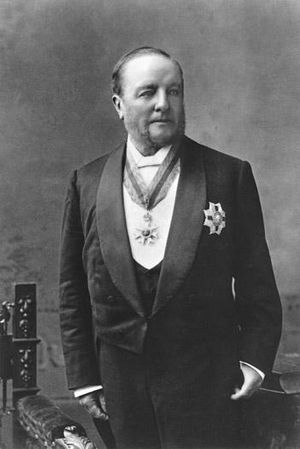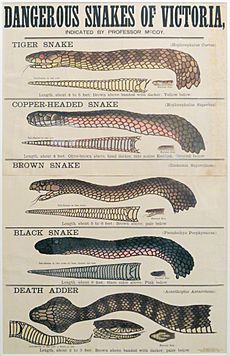Frederick McCoy facts for kids
Quick facts for kids
Sir Frederick McCoy
|
|
|---|---|
 |
|
| Born | 1817 |
| Died | 16 May 1899 Melbourne
|
| Occupation | Professor of natural sciences at the University of Melbourne |
| Awards | Murchison Medal (1979) Clarke Medal (1881) |
Sir Frederick McCoy (born in 1817, died May 13, 1899) was an important Irish scientist. He studied fossils (a palaeontologist) and animals (a zoologist). He also managed museums. He did a lot of his work in Australia. He is famous for starting the Botanic Garden at the University of Melbourne in 1856.
Contents
Early Life and Education
Frederick McCoy was born in Dublin, Ireland. While some records say he was born in 1823, it is more likely he was born in 1817. He studied in Dublin and at Cambridge. His early studies were for a career in medicine.
Studying Fossils and Ancient Life
Even though he studied medicine, Frederick McCoy became very interested in natural history. He especially loved palaeontology, which is the study of ancient life through fossils.
When he was only 18, he published a book about fossils. It was called Catalogue of Organic Remains. He helped another scientist, Sir R.J. Griffith, study fossils from ancient rocks in Ireland. This led to two more books about Irish fossils.
In 1846, a famous geologist named Adam Sedgwick asked McCoy to help him. McCoy spent four years organizing fossils at the Woodwardian Museum in Cambridge. Sedgwick said McCoy was an "excellent naturalist" and an "incomparable" palaeontologist. Together, they wrote an important book about British fossils. In 1850, McCoy became a professor of geology at Queen's College, Belfast.
McCoy also studied the teeth of an extinct animal called Thylacoleo. This animal was a meat-eating marsupial, sometimes called a "marsupial lion."
Working in Australia
In 1854, Frederick McCoy moved to Australia. He became a professor of natural science at the University of Melbourne. He taught many subjects for over 30 years. These included chemistry, animals, plants, and geology. Even though he taught many things, he was best known for his work with fossils.
In 1857, he took charge of the National Museum of Natural History and Geology in Melbourne. He convinced the university and the government to build a new home for the museum. It reopened in 1864 as the National Museum of Victoria. McCoy collected many natural history and geological items for the museum. He also set up a library for scientists to use for their research. He bought specimens like mammals, insects, shells, and bird skins from other famous scientists.
McCoy also worked with the Geological Survey of Victoria. He wrote books about the fossils found in Victoria. These were called Prodromus of the Palaeontology of Victoria. He also wrote about the animals of Victoria in Prodromus of the Zoology of Victoria. He was the president of the Royal Society of Victoria in 1864.
Frederick McCoy described three types of Australia's venomous snakes between 1878 and 1879. One of these was the Oxyuranus microlepidotus, also known as the inland taipan. This snake is thought to be the most venomous snake in the world.
McCoy helped start a group that wanted to bring animals from other countries to Australia. This was called the "Acclimatisation Society." They released fish, mammals, and birds into Australia. This often had a bad effect on the local environment. McCoy hoped to hear English songbirds instead of the sounds of the Australian bush. He even celebrated when European rabbits and starlings were successfully brought in. These animals later became pests for farmers.
His Views on Life's Origins
Frederick McCoy was a Christian who believed that life on Earth was created by a divine plan. He did not believe in evolution or natural selection. He thought that fossils showed that new species appeared suddenly and then disappeared. He believed this sudden appearance was part of a supernatural plan. This idea is sometimes called "progressive creationism."
Later Life and Recognition
McCoy wrote many scientific papers throughout his life. He continued his scientific work for 58 years. His last paper was published in May 1899, the same month he died.
He received several important awards for his work. He was given the Murchison Medal in 1879. He became a Fellow of the Royal Society (F.R.S.) in 1880. He also received an honorary science degree from the University of Cambridge.
In 1886, he was made a Companion of the Order of St Michael and St George (CMG). In 1891, he was made a knight (KCMG), which means he could use the title "Sir." He died in Melbourne on May 16, 1899.
A type of Australian lizard, Anepischetosia maccoyi, is named after him. The McCoy Society for Field Investigation and Research was started in his honor in 1935 at the University of Melbourne.


